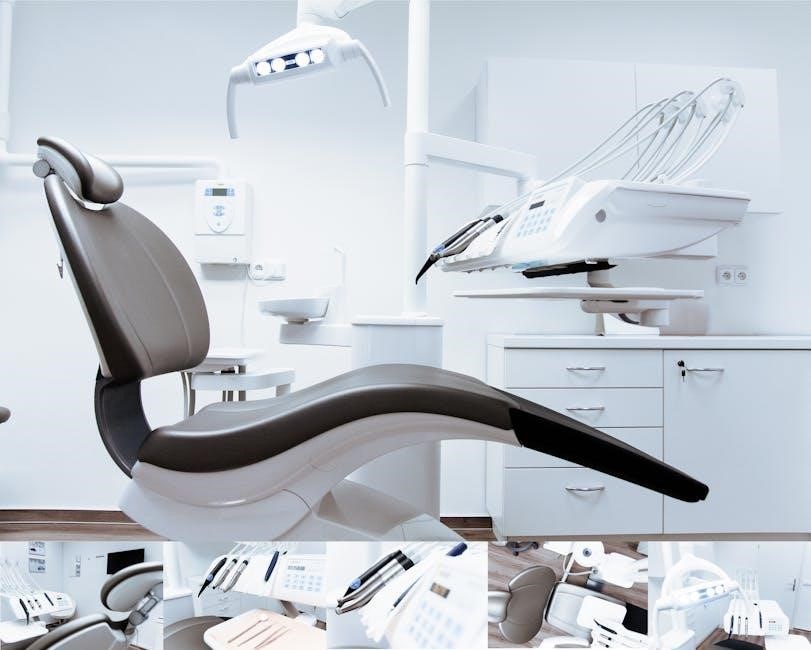ED facility-level coding guidelines ensure accurate reimbursement and compliance with regulations․ They provide standardized methods for assigning codes based on patient visits and services in emergency departments, optimizing efficiency and reducing errors․
1․1․ Understanding the Importance of Coding Guidelines in ED Facilities
Coding guidelines are essential for ensuring accurate and consistent coding practices in ED facilities․ They help standardize documentation, reduce errors, and ensure compliance with regulatory requirements․ By following these guidelines, facilities can optimize reimbursement, improve data integrity, and enhance patient care tracking․ Proper coding also supports compliance with Medicare and other payer policies, reducing audit risks․ Additionally, guidelines ensure clarity in medical decision-making and resource utilization, which are critical for accurate billing and operational efficiency․ Adhering to these standards fosters transparency and accountability, making them a cornerstone of effective ED facility management․
1․2․ Overview of the ED Facility Coding Process
The ED facility coding process involves assigning accurate codes for services provided during patient visits․ It begins with patient registration and documentation of clinical services, followed by detailed chart reviews․ Clinicians document patient evaluations, treatments, and medical decision-making (MDM), which guide coders in assigning appropriate E/M levels․ Facility-specific guidelines ensure compliance with regulations and payer requirements․ Coders then translate clinical data into standardized codes, reflecting the intensity of care and resources used․ This process ensures accurate billing, reimbursement, and data tracking, while maintaining compliance with legal and operational standards․ Regular updates and training keep the process aligned with evolving coding guidelines․
1․3․ Key Stakeholders Involved in ED Coding
Key stakeholders in ED coding include emergency physicians, coders, compliance officers, and billing specialists․ Physicians provide detailed documentation necessary for accurate code assignment․ Coders interpret clinical data to assign appropriate E/M levels and ensure compliance․ Compliance officers oversee adherence to regulations, preventing audits and errors․ Billing specialists ensure correct reimbursement by accurately translating codes into claims․ Additionally, healthcare administrators and IT specialists support the process by maintaining EHR systems and providing training․ Collaboration among these stakeholders ensures efficient, accurate, and compliant coding practices, ultimately benefiting patient care and facility operations․ Their roles are essential for maintaining integrity in the coding process․

Understanding E/M Levels in ED Coding
E/M levels categorize ED visits based on patient acuity, documentation, and resource use․ They standardize coding practices, ensuring accurate reimbursement and compliance with regulatory guidelines․
2․1․ Definition and Purpose of E/M Levels
E/M (Evaluation and Management) levels are standardized codes representing the complexity of patient visits․ They range from Level 1 (low complexity) to Level 5 (critical cases)․ These codes ensure accurate billing, reflecting the resources and time spent on patient care․ The purpose of E/M levels is to provide a structured framework for documenting clinical decision-making, patient acuity, and service intensity․ This system helps facilities comply with coding regulations and ensures fair reimbursement for ED services, aligning documentation with clinical practices and operational needs․ Understanding E/M levels is crucial for maintaining coding accuracy and operational efficiency in emergency departments․
2․2․ Factors Influencing E/M Level Assignments
E/M level assignments are influenced by several factors, including the complexity of the patient’s condition, the extent of documentation provided, and the time spent on patient care․ The severity of symptoms, number of diagnoses, and risk of complications also play a role․ Additionally, the clinician’s documentation of medical decision-making (MDM) is critical, as it reflects the intensity of care provided․ Coding guidelines and institutional policies further shape E/M level assignments, ensuring consistency and compliance․ Accurate assignment of these levels is essential for proper reimbursement and reflects the quality of care delivered in emergency settings․
2․3․ Challenges in Determining the Correct E/M Level
Determining the correct E/M level in ED coding can be challenging due to inconsistent documentation and varying interpretations of guidelines․ Clinicians may understate or overstate the complexity of care, leading to coding errors․ Time spent on patient care is often difficult to quantify, and the subjective nature of medical decision-making (MDM) adds complexity․ Additionally, differing institutional policies and evolving coding regulations can create confusion․ Coders must rely on clear documentation and standardized guidelines to ensure accurate E/M level assignments, balancing clinical accuracy with regulatory compliance to avoid reimbursement issues․

Medical Decision-Making (MDM) in ED Coding
MDM is critical in ED coding, guiding accurate code assignments and ensuring compliance with regulations․ It reflects the complexity of care and clinical judgment․
3․1․ Role of MDM in Facility-Level Coding
Medical Decision-Making (MDM) plays a pivotal role in facility-level coding by standardizing how clinical decisions are translated into accurate codes․ MDM ensures that the complexity and acuity of patient care are reflected in coding, supporting appropriate reimbursement and compliance with regulations․ It helps coders understand the clinical rationale behind provider decisions, enabling precise code assignments․ MDM also serves as a bridge between clinical documentation and coding guidelines, fostering consistency and reducing errors․ By integrating MDM into facility-level coding processes, ED facilities can enhance accuracy, streamline audits, and ensure that coding aligns with the quality of care provided․
3․2․ Documenting MDM for Compliance and Accuracy
Accurate documentation of Medical Decision-Making (MDM) is critical for compliance and coding accuracy in ED facilities․ Clinicians must clearly articulate the complexity of diagnoses, treatments, and patient risks in medical records․ Detailed documentation ensures that coders can assign the correct E/M levels and facility codes․ It also supports compliance with Medicare guidelines and reduces the risk of audits․ Proper MDM documentation reflects the clinical judgment and rationale behind treatment decisions, ensuring that the coding aligns with the patient’s condition and care provided․ This consistency is essential for accurate reimbursement and maintaining regulatory standards․
3․3․ Common Pitfalls in MDM Documentation
Common pitfalls in MDM documentation include vague or incomplete notes, failing to link interventions to patient conditions, and omitting risk factors․ Clinicians often overlook documenting the rationale behind treatment changes or potential complications, leading to coding errors․ Additionally, inconsistent or templated documentation can obscure the true complexity of MDM, affecting E/M level assignments․ Ensuring that each entry is specific, detailed, and tied to clinical outcomes helps avoid these issues and supports accurate coding․ Addressing these pitfalls improves compliance and reduces the risk of audits or reimbursement discrepancies․

Compliance and Regulatory Considerations
Compliance with Medicare guidelines and regulatory standards is critical for ED facility coding․ Accurate documentation ensures proper reimbursement, avoids audits, and maintains adherence to legal requirements․
4․1․ Medicare Guidelines for ED Facility Coding
Medicare guidelines play a pivotal role in ED facility coding․ They establish criteria for assigning codes based on patient encounters, ensuring accurate billing and compliance․ Facilities must adhere to specific documentation requirements, such as the timing of inpatient admissions and the medical necessity of services․ Proper coding under these guidelines helps prevent audits and ensures proper reimbursement․ Staying updated with Medicare’s evolving policies is essential for maintaining compliance and avoiding penalties․
4․2․ Avoiding Coding Errors to Prevent Audits
Coding errors can trigger audits, leading to financial penalties and operational challenges․ To prevent this, ED facilities must ensure accurate and compliant coding practices․ Clinicians should thoroughly document patient encounters, including medical necessity and services provided․ Regular training and updates on coding guidelines are essential to minimize mistakes․ Leveraging technology, such as EHRs and automated tools, can also reduce errors․ Facilities should implement internal audits to identify and correct issues before they escalate․ By prioritizing precision and compliance, ED facilities can avoid audits and maintain seamless operations․
4․3․ Staying Updated with Coding Regulation Changes
Staying informed about coding regulation updates is crucial for compliance and accurate reimbursement․ ED facilities should regularly review official CMS updates, attend coding workshops, and subscribe to industry newsletters․ Coding guidelines often evolve, and staying current ensures adherence to the latest standards․ Facilities can leverage resources like the ACEP coding model and professional organizations for guidance․ Regular training sessions and collaboration with coding experts help maintain accuracy․ By staying proactive, ED facilities can adapt to changes seamlessly, ensuring compliance and avoiding payment issues․ Continuous learning is key to mastering evolving coding requirements and maintaining operational efficiency․

Documentation Best Practices
Documentation best practices in ED coding emphasize clear, concise records of patient care, ensuring compliance and accurate reimbursement․ EHRs help standardize and enhance documentation quality effectively․
5․1․ Clinician Documentation for Accurate Coding
Clinician documentation is critical for accurate coding in ED facilities․ Clear, detailed records of patient history, examinations, diagnoses, treatments, and outcomes ensure proper code assignment․ EHRs help standardize documentation, reducing errors and improving compliance․ Clinicians should document all relevant details, including medical decision-making processes, to support accurate coding․ Templates or guidelines can guide clinicians to include necessary elements consistently․ Thorough documentation not only aids coders but also ensures compliance with regulations and proper reimbursement․ It reflects the complexity of care provided, making it essential for facility-level coding accuracy and compliance․
5․2․ The Role of EHRs in Enhancing Documentation
EHRs play a pivotal role in enhancing documentation for ED facility coding․ By standardizing data collection and ensuring real-time updates, EHRs improve accuracy and reduce errors․ They provide structured templates for documenting patient demographics, diagnoses, medications, and treatment plans, making it easier for coders to assign accurate codes․ EHRs also integrate with coding systems, streamlining the process and reducing manual entry․ Additionally, they offer tools for tracking clinical decisions and outcomes, ensuring compliance with coding guidelines․ Enhanced documentation through EHRs supports accurate reimbursement and improves overall coding efficiency in emergency departments․
5․3․ Ensuring Consistency in Coding and Documentation
Consistency in coding and documentation is achieved through standardized protocols and ongoing training․ Facilities must implement regular audits and feedback mechanisms to identify and address discrepancies․ Collaboration between coders and clinicians ensures accurate and uniform documentation․ Leveraging EHRs with built-in coding guidelines further enhances consistency․ Continuous quality improvement initiatives help maintain high standards, reducing errors and ensuring compliance with regulations․ By fostering a culture of precision and teamwork, ED facilities can achieve reliable and consistent coding practices that support accurate reimbursement and optimal patient care․

Facility-Specific Coding Guidelines
Facility-specific coding guidelines are tailored to each institution’s unique resources and policies․ They ensure alignment with organizational goals, enhancing compliance and efficiency in emergency department coding practices․
6․1․ Understanding Facility-Level Coding Policies
Facility-level coding policies are tailored to each institution’s unique needs and resources․ These policies standardize coding practices, ensuring compliance with regulatory requirements and accurate reimbursement․ They outline specific guidelines for documentation, E/M level assignments, and medical decision-making (MDM) to reflect the facility’s operational context․ Understanding these policies is crucial for coders to accurately assign codes and maintain consistency․ They also address facility-specific challenges, such as resource availability and patient acuity, ensuring coding aligns with the institution’s capabilities․ By adhering to these policies, facilities can mitigate risks, optimize revenue, and support high-quality patient care through precise and compliant coding practices․
6․2․ Customizing Guidelines for Institutional Needs
Customizing coding guidelines to meet institutional needs ensures alignment with the facility’s unique patient population, resource availability, and operational workflows․ Each ED facility has distinct characteristics, such as patient acuity, staffing models, and technology infrastructure, which influence coding practices․ By tailoring guidelines, facilities can address specific challenges and optimize reimbursement․ Customization involves adapting general coding principles to the institution’s environment while maintaining compliance with regulatory standards․ This approach enhances accuracy, reduces errors, and streamlines the coding process, ensuring that guidelines are practical and relevant to the facility’s daily operations․ Regular reviews and updates are essential to reflect evolving institutional needs and industry changes․
6․3․ Impact of Facility Resources on Coding Practices
Facility resources significantly influence ED coding practices, as the availability of technology, staffing, and infrastructure shapes coding efficiency and accuracy․ EDs with advanced EHR systems can leverage built-in algorithms for E/M level assignments, streamlining the process․ Clinician documentation quality, supported by facility resources, directly impacts coding precision․ Institutions with robust training programs and coding expertise often achieve higher compliance rates․ Resource limitations may necessitate customization of guidelines to ensure practical application․ Aligning coding practices with available resources ensures sustainable, effective, and compliant coding processes tailored to the facility’s unique operational environment and patient care demands․

Training and Education for Coding Staff
Regular training and education are crucial for coding staff to stay updated on guidelines, ensuring accuracy and compliance․ Ongoing programs enhance skills in E/M levels and MDM․
7․1․ Importance of Ongoing Training in ED Coding
Ongoing training is essential for ED coders to adapt to evolving guidelines and ensure compliance․ Regular updates help coders understand new regulations, enhancing accuracy and reducing errors․ Training also improves documentation skills, ensuring clinicians’ notes align with coding requirements․ Continuous education addresses knowledge gaps, especially in complex areas like E/M levels and MDM․ It fosters consistency, preventing reimbursement issues and audit risks․ Investing in coder training ensures high-quality data, supports facility operations, and maintains patient care integrity, making it a critical investment for ED facilities․
7․2․ Best Practices for Coding Education Programs
Effective coding education programs require a structured approach to ensure coders stay updated and proficient․ Regular updates on coding guidelines and regulations are crucial․ Interactive learning formats, such as workshops and webinars, enhance engagement․ Tailored modules for different skill levels and roles improve relevance․ Real-world examples and case studies help apply concepts practically․ Incorporating assessment tools ensures understanding and identifies knowledge gaps․ Collaboration between coders and clinicians fosters accurate documentation practices․ Recognizing and rewarding mastery of coding skills motivates continuous improvement․ A well-designed program ensures consistency, accuracy, and compliance, ultimately supporting the facility’s financial and operational goals․
7․3․ Addressing Knowledge Gaps in Coding Teams
Identifying and addressing knowledge gaps in coding teams is essential for maintaining accuracy and compliance․ Conduct regular assessments to pinpoint areas where coders need improvement․ Provide targeted training sessions, focusing on specific coding challenges or updates in guidelines․ Encourage continuous learning through access to updated resources and industry publications․ Foster collaboration among team members to share insights and best practices․ Implement mentorship programs pairing experienced coders with less experienced staff․ Regular feedback and performance reviews help monitor progress and ensure consistent improvement․ Addressing knowledge gaps proactively enhances overall coding accuracy and supports the facility’s operational efficiency․

Auditing and Quality Assurance
Regular audits ensure coding accuracy and compliance․ Data analysis identifies trends, while corrective actions improve processes․ Quality assurance fosters a culture of precision and accountability in ED coding․
8․1․ Implementing Regular Coding Audits
Regular coding audits are essential for ensuring compliance and accuracy in ED facility coding․ These audits should be conducted periodically to identify and address coding errors․ The process involves reviewing a sample of patient records to verify that codes accurately reflect the services provided․ Audits may be performed internally or by external consultants․ They help in identifying trends, such as frequent miscoding of specific procedures or diagnoses․ Corrective actions, including staff training, are implemented to improve coding practices․ By fostering transparency and accountability, regular audits enhance the overall quality of coding in ED facilities․
8․2․ Identifying and Correcting Coding Errors
Identifying coding errors is critical to maintaining compliance and accuracy in ED facility coding․ Errors can arise from outdated guidelines, insufficient documentation, or misinterpretation of codes․ Regular audits help pinpoint these issues, while detailed documentation ensures clarity․ Clinicians must accurately document patient encounters, including the medical decision-making process, to support correct coding․ When errors are detected, corrective actions include revising codes, updating records, and providing feedback to staff․ Timely resolution of errors prevents financial penalties and ensures proper reimbursement․ This process underscores the importance of ongoing education and collaboration between coders and clinicians in ED facilities․
8․3․ Continuous Quality Improvement in Coding
Continuous quality improvement (CQI) in ED coding involves ongoing efforts to enhance accuracy, efficiency, and compliance․ Regular audits and feedback loops help identify error patterns and areas for staff training․ By analyzing data from audits, coding teams can refine processes and implement targeted improvements․ CQI also involves leveraging technology, such as data analytics, to monitor performance metrics and track progress over time․ Staying updated with regulatory changes and best practices ensures coding standards remain aligned with industry expectations․ This proactive approach fosters a culture of excellence, ultimately improving patient care and facility financial stability․
The Role of Technology in ED Coding
Technology enhances ED coding efficiency through EHRs, automation tools, and data analytics, ensuring accurate code assignments and real-time insights for improved decision-making and compliance with guidelines․
9․1․ Leveraging EHRs for Coding Efficiency
Electronic Health Records (EHRs) play a pivotal role in streamlining ED coding processes by providing centralized access to patient data, including demographics, diagnoses, and lab results․ EHRs enable coders to efficiently assign accurate codes by leveraging built-in algorithms and hard-coded E/M levels, reducing manual errors․ Additionally, EHRs facilitate real-time data validation, ensuring compliance with coding guidelines and improving consistency․ By integrating patient-level variables and clinical documentation, EHRs enhance the speed and accuracy of code assignments, ultimately supporting better reimbursement outcomes and regulatory adherence in emergency department settings․
9․2․ Using Automation Tools for Accurate Coding
Automation tools significantly enhance coding accuracy by streamlining the assignment of E/M levels and procedure codes․ These tools utilize artificial intelligence and machine learning to analyze clinical documentation, ensuring compliance with coding guidelines․ Automation reduces manual errors by identifying relevant data points and applying standardized coding rules․ Natural language processing capabilities extract information from unstructured clinical notes, improving efficiency․ Additionally, automation tools provide real-time feedback, flagging potential coding discrepancies for review․ By integrating with EHRs, these tools enable coders to focus on complex cases, ensuring accurate and efficient coding outcomes while maintaining regulatory compliance in ED facilities․
9․3․ Data Analytics for Coding Performance Metrics
Data analytics plays a crucial role in monitoring and improving coding performance within ED facilities․ By leveraging data from EHRs and coding systems, analytics tools generate metrics on coding accuracy, productivity, and compliance․ These insights help identify trends, such as common coding errors or inefficiencies in the coding process․ Customizable dashboards allow coding managers to track key performance indicators, like error rates or coding completion times․ Predictive analytics can also forecast potential issues, enabling proactive measures to enhance coding accuracy and maintain compliance with regulatory guidelines, ultimately improving overall financial and operational outcomes for the facility․

Challenges and Solutions in ED Coding
ED coding faces challenges like regulatory changes and documentation complexity․ Implementing solutions such as ongoing training and leveraging technology can enhance accuracy and compliance, ensuring optimal outcomes․
10․1․ Common Challenges Faced by Coders in ED Facilities
Coders in ED facilities encounter challenges like rapidly changing regulations, complex documentation requirements, and varying E/M levels․ Accurate coding demands precise clinical details, often incomplete or inconsistent․ Additionally, understanding facility-specific policies and staying updated with coding guidelines can be overwhelming․ Another challenge is assigning the correct E/M levels, as they depend on factors like medical decision-making and documentation clarity․ These issues can lead to coding errors, compliance risks, and reimbursement delays․ Addressing these challenges requires ongoing training, clear communication, and leveraging technology to streamline processes and improve accuracy across all aspects of ED coding and documentation practices․
10․2․ Strategies to Overcome Coding Obstacles
To overcome coding challenges, coders should prioritize ongoing education and training, focusing on updates in regulations and documentation best practices․ Leveraging EHRs and automation tools can streamline processes and reduce errors․ Regular coding audits help identify and correct issues early, ensuring compliance․ Clear communication between clinicians and coders is essential to clarify documentation ambiguities․ Additionally, adopting standardized coding guidelines tailored to facility-specific needs can enhance accuracy․ Investing in advanced technology, such as AI-driven coding assistants, can further improve efficiency and precision․ By implementing these strategies, ED facilities can mitigate coding obstacles and achieve higher accuracy and compliance in their coding practices․
10․3․ Best Practices for Maintaining Coding Accuracy
Accurate coding begins with thorough documentation of patient encounters, including clear details on diagnoses, treatments, and medical decision-making․ Regular audits and quality checks help identify and correct errors, ensuring compliance with guidelines․ Clinicians should be trained to document precisely, aligning with coding standards․ Leveraging technology, such as EHRs and coding software, streamlines the process and reduces errors․ Continuous education for coders and clinicians on updated guidelines is critical․ Establishing standardized coding protocols tailored to facility-specific needs enhances consistency and accuracy․

The Future of ED Facility Coding
The future of ED facility coding involves advancements in AI, machine learning, and enhanced EHR integration, improving efficiency and accuracy in coding processes and compliance․
11․1․ Emerging Trends in Coding Guidelines
Emerging trends in ED facility coding guidelines include the integration of AI and machine learning to enhance accuracy and efficiency․ Automated coding tools are becoming prevalent, reducing manual errors and streamlining processes․ Additionally, real-time data analytics is being leveraged to monitor coding performance and identify areas for improvement․ The adoption of updated coding systems and regulatory changes is also a key focus, ensuring compliance and adapting to evolving healthcare standards․ These trends aim to optimize coding practices, improve reimbursement, and support better patient care outcomes in emergency departments․
11․2․ Impact of AI and Machine Learning on ED Coding
AI and machine learning are revolutionizing ED coding by enhancing accuracy and efficiency․ These technologies analyze large datasets to identify patterns, enabling real-time code suggestions and reducing errors․ AI-driven tools can interpret clinical documentation and assign appropriate codes, ensuring compliance with guidelines․ Machine learning algorithms improve over time, adapting to new coding rules and facility-specific practices․ Additionally, AI can flag incomplete or inconsistent documentation, prompting clinicians to provide more detailed information․ This technology not only streamlines the coding process but also reduces administrative burdens, allowing staff to focus on patient care while maintaining high coding standards․
11․3․ Preparing for Future Changes in Coding Practices
Preparing for future changes in ED coding practices requires a proactive approach․ Staying informed about updates in guidelines and regulations is crucial․ Facilities should invest in ongoing education and training for coding staff to ensure adaptability․ Leveraging technology, such as AI and machine learning, can help streamline processes and improve accuracy․ Regular audits and quality assurance measures should be implemented to identify and address potential gaps․ Collaboration between coders, clinicians, and administrators is essential to ensure seamless transitions․ By fostering a culture of continuous learning and adaptation, ED facilities can maintain compliance and thrive amidst evolving coding standards and practices․
ED facility-level coding guidelines are essential for compliance, efficiency, and accurate reimbursement․ Continuous learning, adaptability, and collaboration among staff ensure high standards and preparedness for future challenges․
12․1․ Summary of Key Takeaways
Effective ED facility-level coding requires understanding guidelines, accurate documentation, and compliance with regulations․ Medical Decision-Making (MDM) is central to assigning correct E/M levels․ Technology, like EHRs and automation tools, enhances efficiency and reduces errors․ Regular training and audits ensure coding accuracy and preparedness for regulatory changes․ Collaboration among clinicians, coders, and administrators is vital for maintaining high standards․ Staying updated with evolving guidelines and leveraging data analytics supports continuous improvement․ By adhering to these principles, ED facilities can optimize reimbursement, reduce compliance risks, and deliver high-quality patient care while adapting to future challenges in coding practices․
12․2․ Final Thoughts on ED Facility Coding Excellence
Achieving excellence in ED facility coding requires a commitment to accuracy, compliance, and continuous learning․ By adhering to guidelines, leveraging technology like EHRs, and fostering collaboration among clinicians and coders, facilities can optimize reimbursement and reduce risks․ Regular training, audits, and a focus on Medical Decision-Making (MDM) ensure high standards․ Embracing emerging trends, such as AI and data analytics, will help facilities adapt to future challenges․ Ultimately, coding excellence supports not only financial stability but also improved patient care and operational efficiency, making it a cornerstone of modern healthcare delivery․
12․3․ Encouraging Ongoing Learning and Adaptation
Ongoing learning and adaptation are crucial for maintaining proficiency in ED facility coding․ Regular training sessions, workshops, and updates on regulatory changes ensure coders stay informed․ Incorporating feedback from audits and peer reviews fosters continuous improvement․ Encouraging collaboration between coding teams and clinicians enhances understanding of documentation needs․ Staying updated with emerging technologies, such as AI-driven tools, helps streamline processes․ By promoting a culture of lifelong learning, facilities can adapt to evolving guidelines and maintain high standards of accuracy and compliance in their coding practices, ensuring long-term success and operational efficiency․